Item added to cart Check Out
Small Steps and Giant Leaps
June 29, 2018 by HQ
This is a story about how we launched Field Notes into space.
Our new “Three Missions” Edition celebrates American space flight. We thought it would be fun to organize a launch of our own, in order to capture a key shot for the film about this Summer release. To achieve this we decided to mount a “Punch-Out and Assemble” Apollo Crew Capsule to a rod. Connect that rod to a box containing a camera and GPS tracking unit. Attach the box to a parachute and a big weather balloon filled with helium, and then send the whole rig up into the sky. Easy, right?
The plan was to launch two separate balloons, about an hour apart, doubling our chances for recovery and success. Bryan and I met up with Steve in Manchester, Iowa on Tuesday, June 5th about 7pm. We drove around town looking for a safe place to launch. The conditions needed to be perfect: we needed a flat plot of land without a lot of trees, power lines, or people nearby, plus we wanted a relative amount of privacy, so we could make our poor choices in peace. Ultimately we decided that the Delaware County Fairgrounds would be a perfect location.

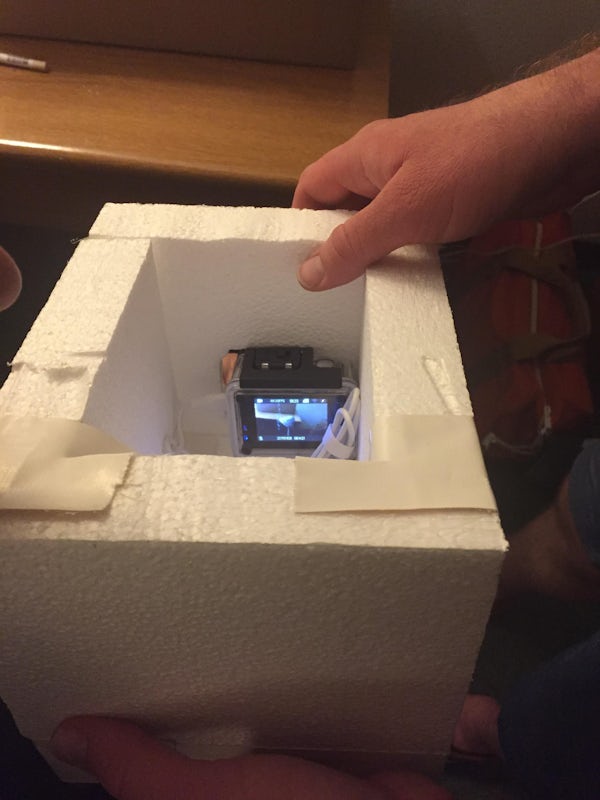
Science meets Bourbon
In the month leading up to the launch, Bryan and Steve had done meticulous calculations to anticipate the trajectory and altitude of the balloons, taking weight, wind direction, pounds of helium, and more into account. Bryan had built the payload rigs out of Styrofoam, a lightweight materials that would also float in case it landed in say, a tiny pond or a giant lake, and we knew the length of cord that we would need to have between the balloon and the parachute and the parachute to the payload (15' on each end). We spent the night before the launch in our motel room sipping some “local” bourbon we’d picked up in Galena (made in Indiana!), checking all the equipment, tying, retying, and taping a bunch of knots, and hoping that the whole thing wasn’t going to be a disaster.
Steve had consulted with the FAA ahead of time and when he called them around midnight to request our launches be included in the daily report for area pilots, he was informed that the FAA computer was down. A friendly night-shift technician in Houston (who seemed impressed with our careful planning and calculations) promised to fax (!) the information to the local airports.

Mission Plan
The plan was to track and follow the balloons via GPS devices that we included in the payload containers. Once the weather balloons got high enough, the lack of atmospheric pressure would cause them to expand, and eventually burst, sending the payloads parachuting gently back down to earth. If they landed on someone’s private property, we would hopefully be able to sweet-talk them or ply them with free Field Notes. If no one was there, well, we’d just trespass. We also labeled the boxes carefully with our contact information, hoping that if we were unable to locate the boxes ourselves, that they would eventually be found by a kind person who would reach out to us.

Launch Day
We set off for the launch site (“A” on map below) Wednesday morning at 5:30, geared up with two helium tanks (110lbs and 220lbs), two weather balloons, and a whole lot of optimism. We made some final adjustments to our capsules, taping hand warmers to the GPS devices and battery packs so they wouldn’t freeze up as they approached the outer limits of the atmosphere. We only had two chances to successfully launch these balloons, so we didn’t know how it was going to go. For added fun and excitement, we also put a single Memo Book from our new edition in each payload, so that we could potentially have a couple of super-limited-edition “This One Has Been To Space” Field Notes.
Scrubbed
While Bryan’s calculations turned out to be generally correct, we found it impossible to get an accurate measurement of the balloon’s lift using our handy-dandy fishing scale. So we made an educated guess based on the amount of helium we’d used, then cut the safety line on the balloon. It started to rise — but not very quickly — and then the wind pulled it across the field and straight towards the only tree in the vicinity, with Bryan in hot pursuit. Just before it floated out of reach and into danger, Bryan grabbed the payload and walked it back to the launch site. Phew.
We removed all of our tape, rubber bands, and bindings, and reconnected the balloon to the tank. We added another dozen pounds of helium, tied it all off again, and it was time for Take 2. This re-launch was a lot more successful. It rose quickly, and we were able to watch it drift up into the morning sky and off into the distance. We called this capsule Mercury.

Launch Two
The second balloon (Gemini) went more smoothly. We sorta knew what we were doing by this point. So, after answering a few friendly questions from a bewildered Manchester Police officer, we got back to work. We quickly got Gemini up in the air, and let it do its thing. Then the tracking began.
Do You Read Me?
The GPS trackers would broadcast their positions every ten minutes, so we we’d be able to track them with a phone app until they got out of range above 20,000 feet. After that, we’d lose all contact and only reconnect when they fell back within range. We’d used this handy website to predict a general flight path (green line on map below), so we had a very rough idea where they’d come down. We saw that Mercury, as expected, was heading towards Montecello, Iowa. One of the best tips we’d found online was to go eat some pie while you wait nervously, so we met up at the Fancy Fritter for an early lunch. We ate salads, not pie, because we’re masochists.
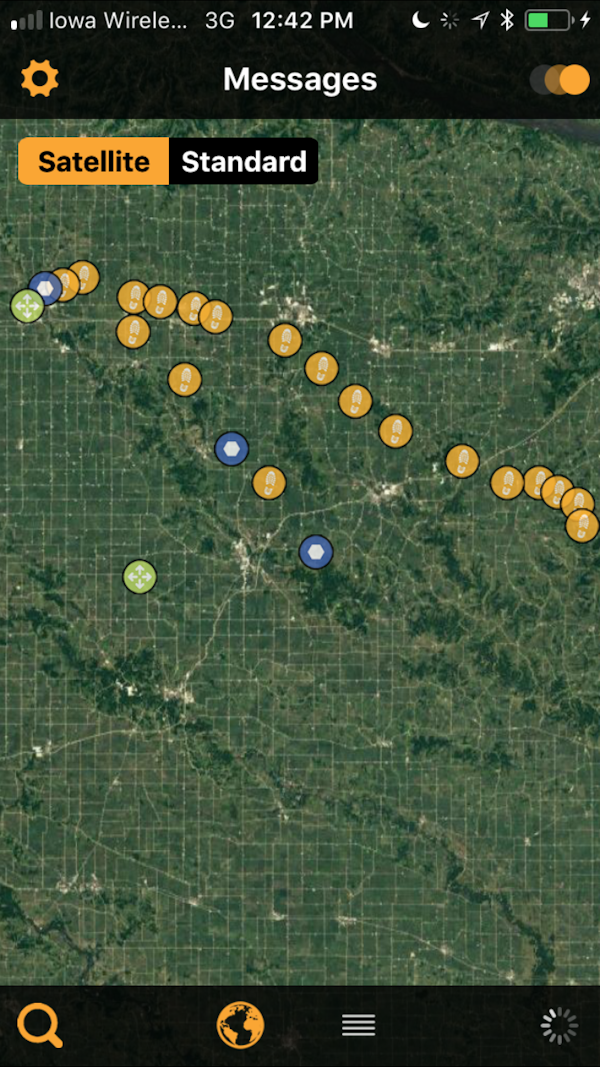
Mobile phone data coverage in the area (even in towns) was dodgy, and Steve and Bryan’s phones were not much use. Thankfully, I had a different carrier with better coverage, so we used my phone as the primary tracker for the rest of the day. We lost the signal from Mercury as expected, but then just an hour later, it broadcast new movement, from near where the signal was lost (“C” on map). We should have received pings as it fell, and then a continuous ping from its landing spot, but after another half hour, we’d only seen that single alert. Then, as we headed to the coordinates, we got another ping from Mercury, placing it in a totally different cornfield, ten miles west of the first (“D”). We decided the later signal was more likely to be accurate and headed that way. Meanwhile, we’d lost contact with Gemini as it rose over 20,000 feet.
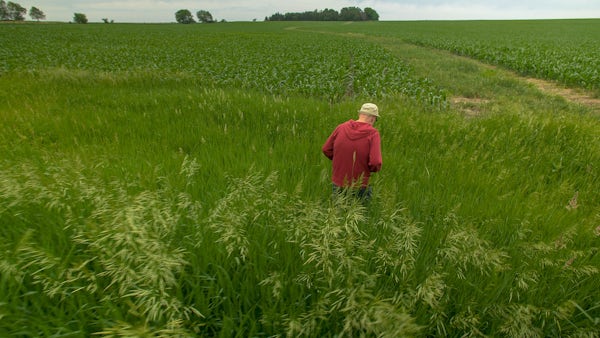
Alas, we had no luck in the indicated location. We looked high and low, but weren’t able to find Mercury. So we went back to the coordinates of the earlier signal. I stayed by the cars in case I needed to explain to a police officer or landowner what we were doing with two cars parked near their property. Steve and Bryan walked a half-mile into a field of soybeans planted amidst the spiky remnants of last year’s corn stalks, and past a duck blind, where it first occurred to them that farmers might shoot at weird city folk before asking questions.

Disappointment Sets In
Still no luck. Feeling discouraged, we decided to leave the Montecello area to try to find Capsule #2, Gemini, which, when we'd lost tracking, had flown much farther east.
At this point, with no signal from either balloon, we were starting to feel discouraged. We had been tracking the boxes, zig-zagging and trespassing all over Northeast Iowa and if we were unable to locate either one, the whole plan for this film would be ruined. We started to rewrite the film in our heads, reshaping it into a sad essay on disappointment. We tried to remain hopeful, but it was a challenge.
At our lowest point, we lost all data coverage in the middle of nowhere. Eventually though, we came across a filling station near Cascade (“E”) that offered snacks for sale and WiFi for free. By this time, Gemini was tracking again, just to the south of us and moving southeast, so we stayed put and watched. Again, we expected a few pings as it fell, and then a final location. Strangely, it continued moving eastward for nearly an hour, over a heavily wooded area with little access from roads. Either the satellite picked it up much higher than 20,000 feet, or the parachute carried it horizontally for quite a while. Eventually we saw that it had come to rest about a half-hour southeast of us (“F”). We jumped in the cars and headed to the spot.
I Need to Take this Call
As the excitement of possibly finding Gemini rose, Bryan’s phone rang from an unknown Iowa number. Assuming a confused farmer had just seen Gemini come crashing down on his field, Bryan answered. Indeed, a capsule had been found! Even more incredibly, the caller identified it as Capsule #1; Mercury! It was found in a cornfield back near Montecello, a few miles from where we’d been looking!
Recovery
Before heading back, we had to locate Gemini. It looked to be not far from the road in another cornfield near Maquoketa Caves State Park. While futzing around at the filling station we noticed that the database created by the GPS included an additional decimal in the coordinates (as opposed to the coordinates displayed on the map). This would theoretically pinpoint the location to within several feet. So we had a pretty good idea of where the capsule would be. We drove up to the Schnoor Family Farm and looked around for someone to talk to. There was no one around. So, Bryan and Steve trespassed again, and again I stayed back at the cars to sweet talk anyone who might show up.
A slight hill blocked our view from the road, but as soon as Steve and Bryan cut through a cattle gate and got ten feet into the field, they called out to me that they could see it! Our coordinates were exact! Minutes later, they resurfaced with the camera box and the parachute. The Apollo capsule however was nowhere to be found. Gulp.
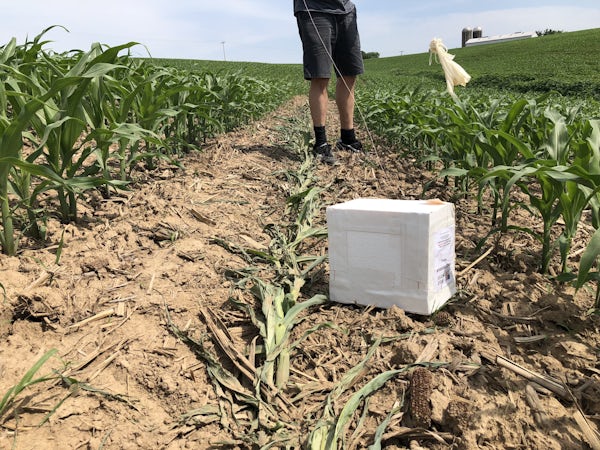

We were thrilled. Filled with adrenaline and covered in dust from hours of driving on dirt roads, we took off back towards Montecello to recover Mercury.

Mercury Dropping
We arrived at Monck Farms (“G”) — not far from our original searches — we were met by a nice family and half a dozen huge dogs, who were quite confused about what they’d found in their field. (The family, not the dogs. Well, maybe, also the dogs.) The box had been found while they were out planting, and they brought it to the house to check it out. It was mostly intact, but the balloon was shredded and twisted around the cords — a piece of art in itself. The Apollo capsule had broken off, but it was found nearby.
We couldn’t believe that we had successfully launched two capsules and recovered them both. When we saw the footage from the cameras, we were blown away.
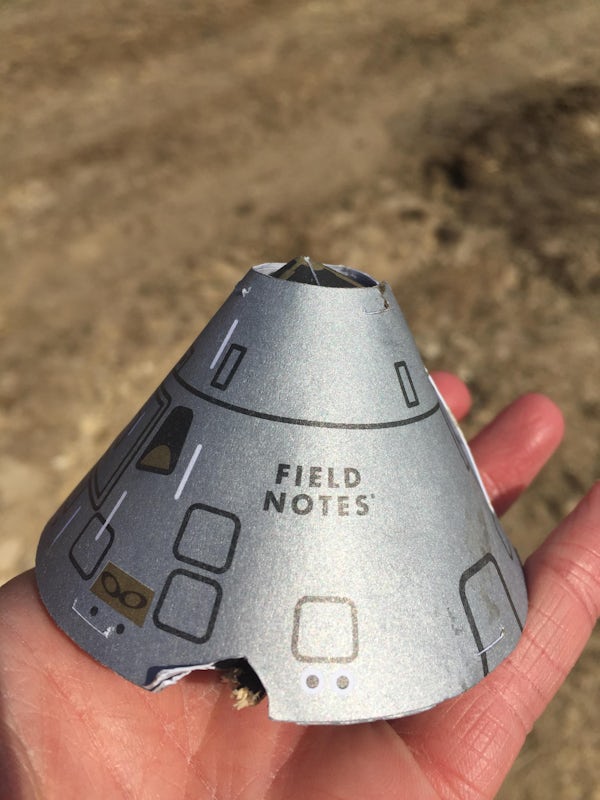
Mission Debriefing
Yes, the footage in the film is the real deal, it’s a shot from Mercury, taken at an altitude of somewhere around 110,000 feet over Iowa.
While watching the footage from Mercury, we found the moment the balloon exploded. It caused a violent shaking, then shreds of the balloon wrapped around the parachute, cord and the arm holding the capsule. It all wadded into a ball of latex, chute and Styrofoam and spun down to earth at terminal velocity. The model apparently broke off the stick just as it hit the ground. Its rapid descent explained the lack of GPS pings, and the force of the impact likely disabled the GPS upon landing.
Gemini landed nearly 70 miles from the launch site, but it's flight path was nearly double that distance. For some unknown reason the camera stopped filming near the peak of its ascent, but before the balloon exploded. Its parachute worked too well, carrying it miles away from its expected landing spot. But, the GPS worked flawlessly. We know that because Bryan forgot to turn it off and it tracked us all the way back to Chicago. The capsule attached to Gemini broke off during descent and is still in Iowa somewhere. If you find it, let us know.
Mission Accomplished.

Three maps, overlayed. "A" is the launch site, in Manchester. The green line is the habhub.org prediction, modeled at launch time of balloon #1. "B" is the predicted apogee, where the ballons were expected to explode. Red indicates GPS tracking of balloon #1. Blue is balloon #2. Other labels are described in the text.